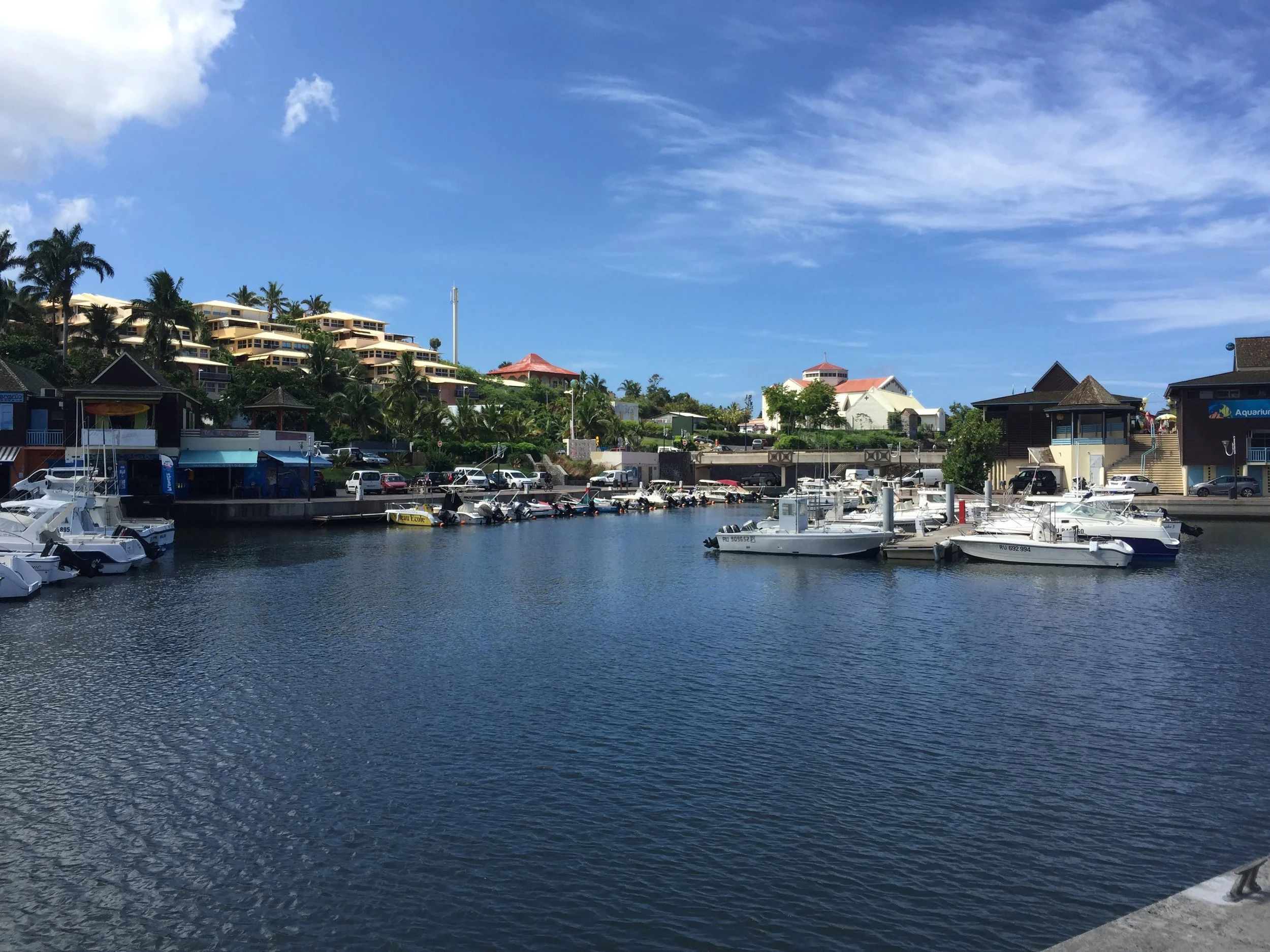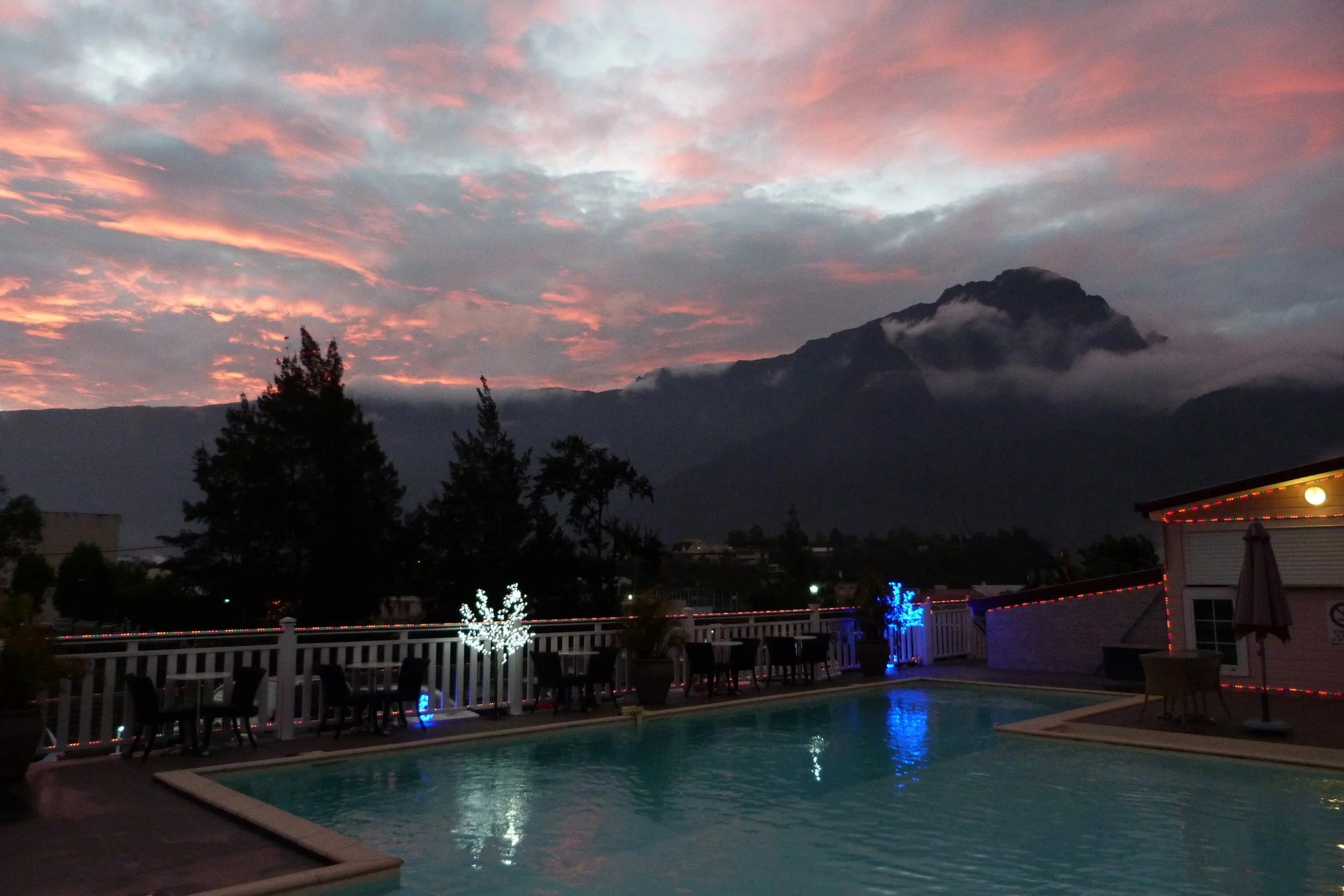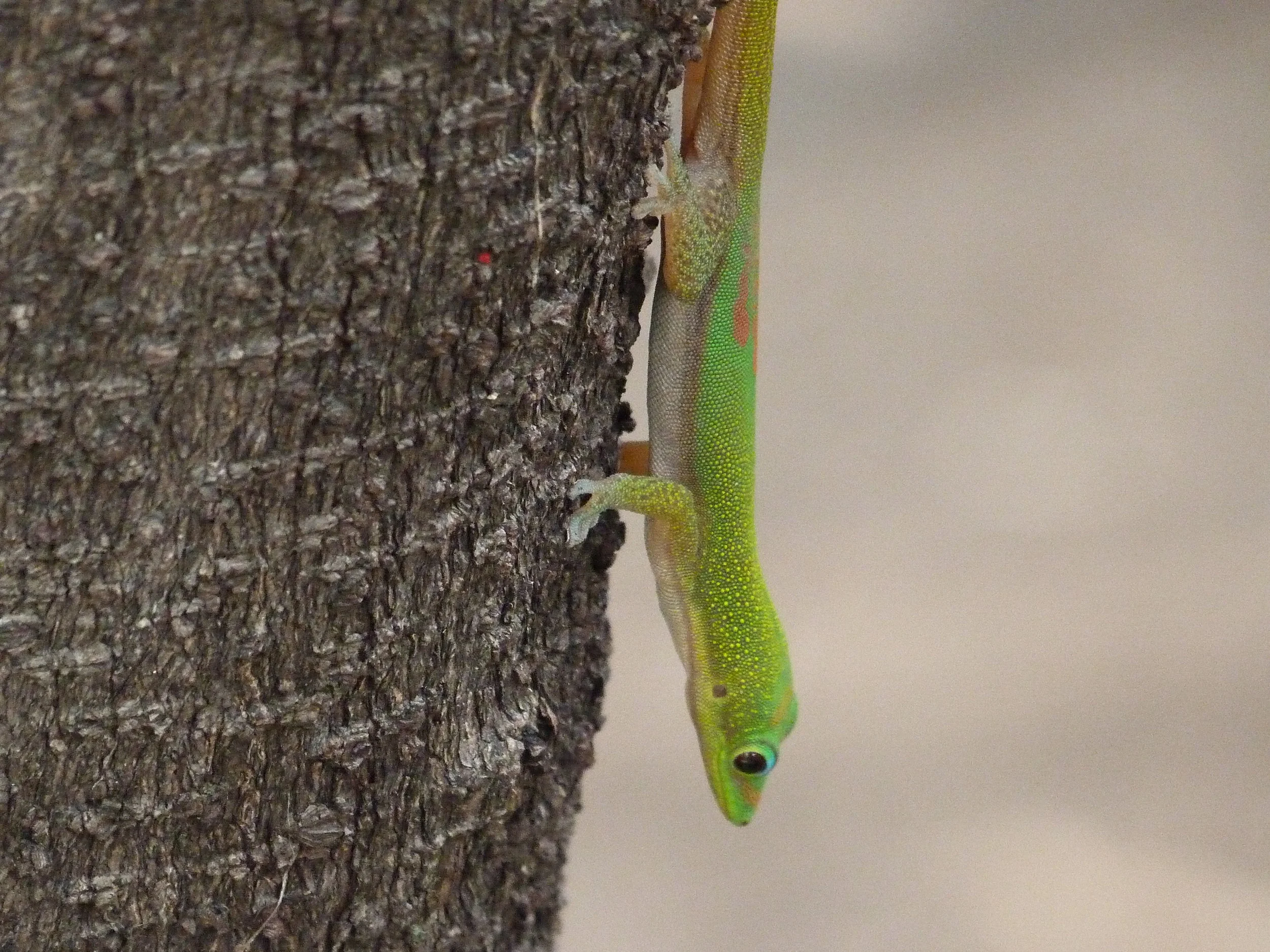January 2015
IT’S AROUND 9.30 on Christmas Eve 2014 and we’re leaving the Hôtel des Neiges in Cilaos on Réunion Island after a Christmas dinner that was … well … a bit weird.
As we step out of the hotel on to the swimming pool terrace, a middle-aged guy gets hold of the karaoke mike and begins to sing a long, mournful, French song in a minor key. I’m still trying to locate the tune when the noise ceases and the lights go out all over town.
It’s a real shame – not just for the vocalist, but for the 5,600 or so residents who have worked so hard to turn the high street and central square into a kind of Santa’s Grotto, 1,214m above sea level in the caldera of an extinct volcano.
Cilaos – it means ‘the place one never leaves’ – has the unusual distinction of holding the record for the greatest amount of rain ever to have fallen in a single place in one day on planet Earth: a remarkable 73 inches in 24 hours. That was in 1952.
As we drove up from the muggy coast earlier that day, we speculated that the record might be broken as a tropical downpour sent rain thrashing through forests and down vertical cliff faces into the road. On the 400 hairpin bends up to ‘the town one never leaves’, we had to swerve constantly to avoid boulders brought down by the rain (and more confident locals happily driving on the wrong side of the road). At one point a rock the size of a man’s head bounced across the tarmac in front of us. At least it explained what caused the unusual dents in the hire car’s roof.
The rain stopped and started, and at various points we got out of the car to have the breath knocked out of us by the view. It really is a stunningly beautiful place.
We were staying at the Hotel Tsilaosa in Cilaosa – a Swiss chalet of a building, with a warm welcome and endlessly charming staff – but it was a B&B and we had to book Christmas Eve dinner (the main event for Reunion Islanders) at the nearby Hôtel des Neiges.
Bizarrely, it turned out to be a buffet featuring a kind of Kentucky Fried turkey and mashed chestnuts, alongside locally grown lentils, langoustine curry and oddments like potato with melted cheese, endive, walnut and blue cheese salad, boiled rice, the kind of tomato sauce you get with spaghetti and rubber-bullet scallops with black pudding. At home, I remembered, we would have had rose-pink beef Wellington with a golden crust – but, hey, that’s travelling for you.
When we got back to the Tsilaosa in the centre of town, the Christmas lights had been knocked out and the nativity scene in the main square was dark. We undressed by torchlight, got into bed and fell asleep, only to be woken twice: once by a member of staff offering us candles, and again when the electricity came back on in the early hours of the morning and the bedroom lit up like the departure lounge of an international airport.
What had happened, we learned later, was that one of those falling rocks had smashed through the cables feeding electricity to Cilaos. It’s a miracle that they had it fixed by sunrise on Christmas day.
The inside of this extinct volcano – the Cirque de Cilaos – is just huge; it’s like something from a Jules Verne novel. Slaves who escaped from the sugar plantations on the hillsides around the coast in the 17th, 18th and early 19th centuries hacked their way through dense vegetation to reach this place – hence ‘the place one never leaves’, or ‘the safe place’ – and some became subsistence farmers. Eventually, hamlets like Iles à Cordes emerged on green volcanic spurs inside the crater, and there are still farmers there growing vegetables and fruit in smallholdings.
Amazingly, there are thriving, if tiny, vineyards and as it happens our host at the Tsilaosa – Pierre Noé Dijoux – is the local expert and has kitted out his wine cellar as a tasting room. (There’s a rather warm feeling of being properly en famille as Pierre, watched by his improbably blonde grandson, shares his knowledge with the small bunch of international guests at an impromptu Christmas Day sampling.)
Réunion Island is not merely French, the French actually consider it to be as much part of France as, say, Lyon or Calais. As a result, and after a disturbing false start, we had taken a domestic flight of 11 hours from Orly Airport in Paris to this relatively small (39 miles long, 28 miles wide) island between Madagascar and Mauritius, with scant passport control at either end.
There are at least four distinct geographies in Réunion. There are the ‘cirques’ – the soaring volcanic ramparts and glistening cloud forests reached by switchback roads, where temperatures dropped to 19C. Then there is the warm (31+C) and populous west coast; the warm, wet and less populated east coast; and the volcanic south. The shield volcano, the Piton de la Fournaise, has erupted more than 100 times since 1640 and is constantly monitored. If you’ve a mind, you can drive up to La Plaine des Sables at 2,260m to take in the bleakness of the cloud-shrouded ash plains. You can even walk up to the caldera of la Fournaise, although it’s a good four-hour hike there and back.
On the emptier east coast, there are sugar, banana and vanilla plantations to visit – or you can go and see Notre Dames des Laves, where locals prayed that molten lava flowing from the volcano would stop before it hit the church. And it did. The solidified lava is there to see, a few feet from the front door.
By contrast, St Gilles-les-Bains (or, as locals like to have it ‘St Chill’) is more obviously aimed at tourists and looks as if it should be somewhere on the Côte d’Azur.
Sugar cane still grows everywhere and is used to produce the island’s local drink, rhum. The Saga du Rhum – an exhibition in a distillery at St Pierre – is worth a visit, if only to discover how very eco-friendly sugar cane is. (As an aside, the sugar cane plantations are a natural habitat for the island’s ubiquitous cockroaches, which sometimes make their way into local hotels.)
If you are active, Réunion is – to use an old cliché – paradise (well there’s a Jardin d’Eden at L’Ermitage les Bains, at least). Canyoning, paragliding, surfing, hiking, paddle-boarding, kayaking, snorkelling and diving are all pretty well catered for.
If you are less daring, or just a little older, there are good restaurants – Villa Vanille at Saint-Leu on the west coast is really good – and the five-star Lux resort at L’Ermitage les Bains is perfect for those who like to lie in the sun. Take the Factor 50 with you though; it can get a bit fierce out there. And don’t forget the Deet – the mosquitoes are hyper-active.
We arranged our holiday through our friends at Halcyon-Collections staying in six different hotels over 14 days. It wasn’t the cheapest holiday we’ve ever had at around £3,500 per person, plus spending money – but I don’t think it will be forgotten quickly.
The best bits
1. The Diana-Dea Lodge at Sainte-Anne on the east coast. A modern and beautifully designed hotel high up on the side of a hill. You can sit in the bath and look at the Indian Ocean, if that’s your thing, and the restaurant is superb. Technical problems with our plane meant that we missed the first night at Diana-Dea and had to stay in an Ibis at Charles de Gaulle airport in Paris instead. The Ibis was fine, but we were still robbed.
2. Villa Bella in Saint-Pierre. The family home of the owner, Erik, an artist, and his partner. Closer to a riad than a standard hotel and achingly beautiful. Great care has been taken over the interior decoration, with gorgeous suites. Breakfast in a kind of arbor in the garden, with Baroque music playing, and Erik’s home made plum tart is an experience. I could have stayed there a week.
3. New Year’s Eve on the beach at L’Ermitage les Bains. The New Year’s Eve dinner at the Lux Resort was ‘obligatory’, which made me wince a bit. But the setting was lovely, the food a revelation and the firework display on the beach, amazing. But not quite as amazing as the sight of hundreds, perhaps thousands, of glowing, red Chinese lanterns floating upwards from every village and beach along that coast.
4. The food. Recommended – Villa Vanille in Saint-Leu, especially for the white tuna and magret de canard; DCP in Saint-Pierre for the freshness and variety of its fish; Diana Dea and the Lux resort for fine-dining. Don’t expect to pay less than about €35 a head anywhere though.
5. The bird life. For some, it’s the coral reefs with the angel fish – for me it’s the birds. A Reunion harrier, a posing buzzard, the startlingly red fody, elusive tropic birds, cheeky bul buls and cocky mynahs, cheered me up endlessly.
5. The cirques. Unforgettable drives and Tolkienesque landscapes. Brilliant.
6. Getting absolutely soaked in Le Fôret de Bébour. Driving through a vast forest at the top of the island, we decided to park and walk to a Gîtes to get some coffee. It was raining. Then it was raining very hard, but it was still warm. Soaked through to our socks it suddenly seemed very, very funny to be sipping coffee and dripping on the floor of a Gîtes in the middle of nowhere. Inner seven-year old stuff. Best left to the therapist.
The worst bits
1. Losing a day because of turbine problems on our Air France flight. Queuing for accommodation vouchers. Queuing again for renewed boarding passes the next day.
2. The heat. Yes, I know, if you can’t stand the heat, etc … But 36C was a touch warm for a Yorkshireman. Escaping to the mountains became a matter of routine.
3. The insects. Specifically, mosquitoes and cockroaches. I applied so much Deet, it melted the cover of my iPhone – and I only got bitten once. My three companions were, at various stages, eaten like pies at a football match. The cockroaches – around 7cm long – were quite interesting. Did you know that if you offer 50 cockroaches three dens, or nests, that each hold 40 they will split themselves into two groups of precisely 25 and occupy just two of them. If one of the nests is for 60, all 50 will pile into that one because they like to be together. Like ants. It’s a kind of intelligence. On the other hand, I’d rather not have them in my bedroom. There is a giant centipede that preys on them in the sugar cane fields, but frankly I like the cockroaches better.











